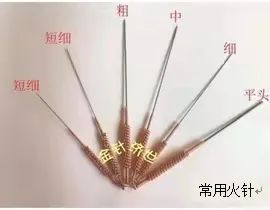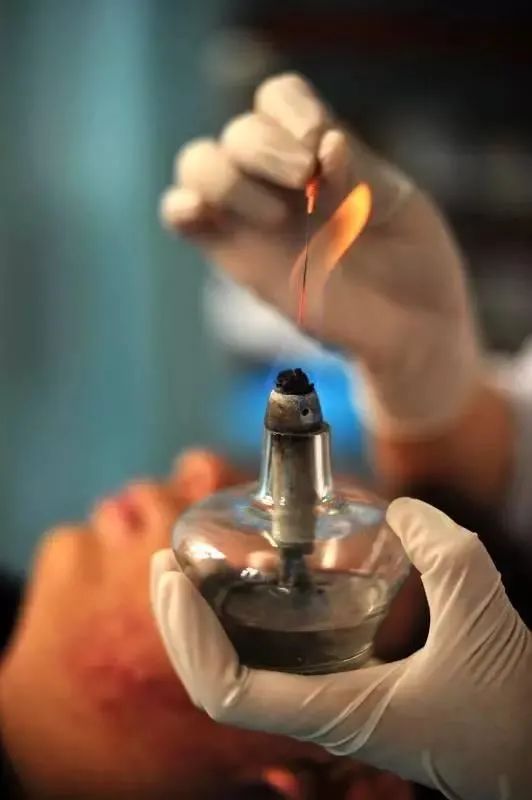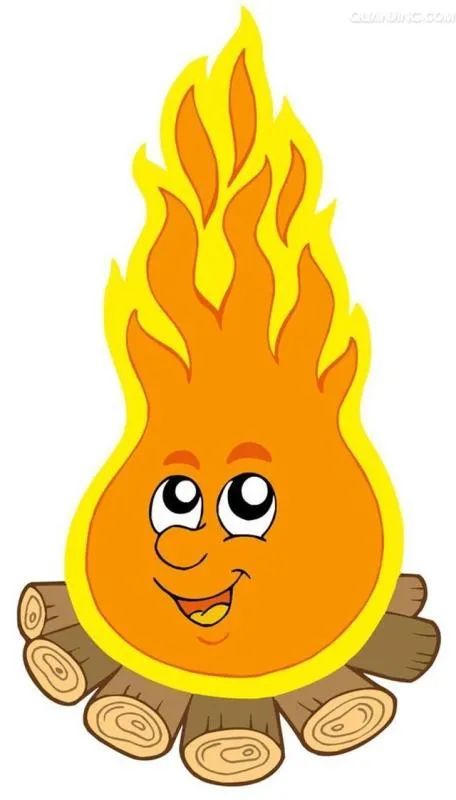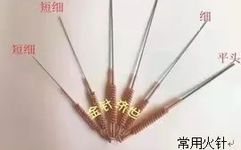Fire needle therapy has a long history and is characterized by its simplicity and rapid effectiveness. It is applicable across various clinical disciplines and has a wide range of effects. Fire needles are made from tungsten-based high-density hard alloys, which are hard and sturdy, possessing high-temperature resistance, minimal deformation, and strong high-temperature hardness. The image below shows several commonly used fire needle instruments.

Fire needle therapy refers to a treatment method that involves heating specially made metal needles (such as tungsten and manganese) until they glow red and then quickly inserting them into specific points or acupoints to prevent and treat diseases. It is a form of acupuncture, historically known as “burning needle”. The technique of fire needle insertion is called “quenching insertion” and includes methods such as needling acupoints, painful points, dense needling, surrounding needling, and dispersing needling.Fire needle therapy combines the dual effects of acupuncture and moxibustion. Its therapeutic mechanism lies in using heat to stimulate acupoints and local areas to enhance the body’s Yang energy, invigorate the righteous Qi, regulate the internal organs, stimulate the meridian Qi, warm the meridians, and promote blood circulation. When applied clinically, it can elevate Yang, promote tissue regeneration, expel pus, relieve pain and itching, and dissipate masses and swellings.1. Principles of Fire Needle Therapy1. Utilizing fire to assist Yang and warm the meridians:By using heat, the meridian Qi is stimulated through acupoints and meridians, which is the foundation of fire needle therapy.2. Opening the door to expel pathogens, dispelling cold and dampness:By cauterizing the skin at acupoints, the meridians are opened, allowing pathogens such as pus, blood stasis, dampness, phlegm, and external evils to exit, thus addressing the root cause of the disease.3. Promoting Qi and relieving stagnation, using heat to draw out heat:By using fire to open the external pathways, toxins can be expelled, which is essential for treating the disease at its source.Through these actions, the therapy achieves the goals of warming and strengthening Yang, promoting tissue regeneration, dispelling cold and dampness, relieving wind and itching, removing stasis and pus, dissipating masses and swelling, alleviating pain, and stopping coughs and wheezing, as well as clearing heat, draining fire, and detoxifying.2. Indications for Fire Needle TherapyFire needle therapy is used to treat a variety of conditions across internal, external, gynecological, and otorhinolaryngological disciplines. It is primarily used for treating conditions such as shoulder periarthritis, low back pain, knee osteoarthritis, and sciatica, as well as surgical conditions like abscesses, lymphadenitis, cysts, and varicose veins of the lower limbs. It is also effective for skin diseases such as moles, warts, herpes zoster, and vitiligo, as well as internal diseases like chronic gastritis, asthma, dysmenorrhea, and sequelae of stroke.3. Techniques of Fire Needle Therapy1. Selecting acupoints and disinfection:The selection of acupoints for fire needle therapy is similar to that for regular acupuncture, but it emphasizes local points based on pain. The patient should be in a comfortable position, preferably lying down. Strict disinfection is required, first using 2% iodine tincture followed by 75% alcohol to remove iodine.2. Heating the needle:Heating the needle is the key to the fire needle technique. The method involves holding an alcohol lamp in the left hand and the needle in the right hand, bringing it close to the treatment area, and quickly inserting the needle after heating. The order of heating is to first heat the needle body and then the needle tip. If the needle body is red but the tip is cold, it is not suitable for insertion.3. Depth of needle insertion:Fire needle operations are generally quick in and out, without retaining the needle. The depth of insertion is determined based on the treatment area and the condition. (1) For the chest and back, shallow insertion of 1-2 fen (0.3-0.6 cm); for limbs, waist, hips, and abdomen, slightly deeper, 2-5 fen (0.6-1.5 cm). (2) For conditions like excess syndrome, abscesses, lymphadenitis, and ganglion cysts, deeper insertion is appropriate; for deficiency syndromes, rheumatic pain, and skin diseases, shallower insertion is recommended.4. Post-needling care:After needle removal, immediately apply pressure to the puncture site with a disinfected cotton ball. For needles inserted less than 3 fen deep, no special treatment is needed; for those deeper than 4 fen, a band-aid may be applied for 1-2 days to prevent infection.

4. Complications of Fire Needle Therapy1. Pain:Generally, only mild burning or warmth is left, which quickly disappears within minutes to tens of minutes. Severe pain in patients is often due to insufficient heating of the needle.2. Bleeding:Bleeding during fire needle insertion is common, as fire needles can enlarge acupoint openings and are often used as effective tools for bloodletting. If a subcutaneous blood vessel is accidentally punctured and bleeding does not stop, apply pressure with a cotton ball for ten minutes. Patients with hemophilia or coagulation disorders should avoid fire needle therapy.3. Infection:Fire needle therapy itself is a benign, mild local burn and generally does not lead to infection. Local puncture sites may show slight redness and swelling, with mild itching, and some patients may experience systemic reactions such as mild chills and fever, which are normal responses to the aseptic inflammatory reaction of the burn. However, if the puncture site is contaminated with water or chemical irritants, it can easily lead to purulent infection.4. Scarring:After fire needle insertion, scabs usually fall off in about two weeks without leaving scars. However, if an infection occurs, scarring is likely.5. Fainting:Fainting during fire needle procedures is rare due to the quick actions and mild pain, but it can occasionally occur.5. Precautions for Fire Needle Therapy1. Patients who are overly nervous, hungry, fatigued, or intoxicated should not undergo fire needle therapy.2. Patients with weak constitutions should pay attention to their position. Diabetic patients and those with low skin resistance should use fire needles with caution. Patients with severe hypertension, heart disease, malignant tumors, or bleeding tendencies should avoid fire needle therapy. Due to the strong stimulation of fire needles, pregnant women and the elderly or frail should not use them.3. Fire needles should not be used on certain body parts, such as major blood vessels, internal organs, and vital organs.4. Caution is advised when using fire needles on the face. Ancient practitioners believed that fire needles should not be used on the face due to the potential for small scars. However, if fine fire needles are used for shallow insertion, they can treat diseases without leaving scars, so the prohibition is not absolute.5. After fire needle insertion, the following three aspects should be noted: First, normal reactions after fire needle therapy may include redness at the puncture site or small red dots raised above the skin, and some patients may experience itching. This is a normal response of the body to fire needle therapy. The puncture site is a mild burn that will disappear on its own after a few days without any treatment. Second, if itching occurs at the puncture site, do not scratch with fingernails, as this may enlarge the red area and affect future treatments. Third, it is best to avoid bathing on the day of treatment to protect the puncture site from water contamination, which could lead to infection.6. Maintain cleanliness after fire needle therapy.7. Avoid eating raw and cold foods during the fire needle treatment period.

TCM Department: Li Hongyan

